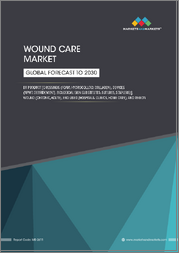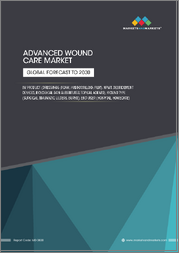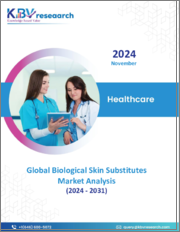
|
시장보고서
상품코드
1534212
세계의 생물학적 피부 대체물 시장 규모 조사 : 유형별, 용도별, 최종 용도별, 지역별 예측(2022-2032년)Global Biological Skin Substitutes Market Size study, by Type, by Application, by End-use and Regional Forecasts 2022-2032 |
||||||
생물학적 피부 대체물 세계 시장은 2023년 약 3억 2,331만 달러로 평가되며, 2024-2032년 예측 기간 동안 8.86% 이상의 건전한 성장률로 성장할 것으로 예상됩니다.
생물학적 피부 대체물은 노출된 피부의 상처를 일시적 또는 영구적으로 덮고 피부 기능을 회복하도록 설계된 인공 조직 제품입니다. 이 제품은 치유되지 않는 만성 궤양 치료와 화상 및 외상성 상처의 상처 덮음에 널리 사용되고 있습니다. 만성 상처의 유병률 증가, 화상 및 외상 발생 건수 증가가 시장 성장의 원동력이 될 것으로 예상됩니다. 또한, 저렴한 가격의 피부 대체 솔루션에 대한 수요 증가와 전 세계 고급 상처 치료 시설의 도입은 시장 확대를 더욱 촉진할 것으로 예상됩니다.
생물학적 피부 대체물 세계 시장은 만성 상처 및 외상 발병률의 증가로 인해 효과적인 치료 옵션이 필요해지면서 생물학적 피부 대체물에 대한 수요가 증가하고 있습니다. 당뇨병성 신경병성 궤양, 욕창, 혈관부전성 궤양과 같은 만성 상처는 의료 서비스 제공자에게 큰 도전이 되고 있으며, 첨단 상처 치료 솔루션의 필요성을 강조하고 있습니다. 생물학적 피부 대체물은 피부 기능을 회복하고 치유를 촉진하는 일시적 또는 영구적인 솔루션을 제공하기 때문에 이러한 증상을 관리하기 위해 점점 더 많이 사용되고 있습니다. 또한, 첨단 상처 치료 시설의 도입이 증가하고 있으며, 이는 시장에 유리한 기회를 제공할 것으로 예상됩니다. 그러나 숙련된 전문 인력의 부족은 2024-2032년 예측 기간 동안 전체 시장 수요를 저해할 것으로 보입니다.
조사 대상 주요 지역으로는 아시아태평양, 북미, 유럽, 중남미 및 기타 지역이 포함됩니다. 2023년 기준 북미가 가장 큰 시장 점유율을 차지했는데, 이는 의료 인프라가 발달하고 창상 관리에 대한 인식이 높아졌으며, 미국과 캐나다의 의료비 지출이 많기 때문으로 분석됩니다. 미국과 캐나다의 높은 의료비 지출에 기인합니다. 이 지역의 선진화된 의료 시설과 지원적인 상환 정책은 이 지역의 시장 지배력을 더욱 강화하고 있습니다. 또한, 아시아태평양은 예측 기간 동안 가장 빠른 CAGR로 성장할 것으로 예상됩니다. 급속한 경제 성장과 혁신적인 창상 관리 기술에 대한 수요 증가는 이 지역의 시장 성장을 촉진할 것으로 예상됩니다. 효과적인 창상 관리를 위한 맞춤형 솔루션 개발에 대한 노력은 생물학적 피부 대체물의 채택을 촉진할 것으로 예상됩니다.
목차
제1장 생물학적 피부 대체물 세계 시장 주요 요약
- 생물학적 피부 대체물 세계 시장 규모와 예측(2022-2032년)
- 지역별 개요
- 부문별 개요
- 유형별
- 용도별
- 최종 용도별
- 주요 동향
- 경기후퇴의 영향
- 애널리스트의 결론과 제안
제2장 세계의 생물학적 피부 대체물 시장 정의와 조사 가정
- 조사 목적
- 시장 정의
- 조사 가정
- 포함과 제외
- 제한사항
- 공급측 분석
- 입수 가능성
- 인프라
- 규제 환경
- 시장 경쟁
- 경제성(소비자의 관점)
- 수요측 분석
- 규제 프레임워크
- 기술의 진보
- 친환경
- 소비자 의식과 수용
- 조사 방법
- 조사 대상 연도
- 통화 환산율
제3장 생물학적 피부 대체물 세계 시장 역학
- 시장 성장 촉진요인
- 만성 창상 및 외상 환자 증가
- 적정 가격의 피부 대체 솔루션에 대한 수요 증가
- 시장 과제
- 숙련된 전문가의 부족
- 시장 기회
- 고도 창상 치료 시설의 도입 확대
- 신흥 시장에서의 확대
제4장 생물학적 피부 대체물 세계 시장 산업 분석
- Porter's Five Forces 모델
- 공급 기업의 교섭력
- 구매자의 교섭력
- 신규 참여업체의 위협
- 대체품의 위협
- 경쟁 기업 간의 경쟁 관계
- Porter's Five Forces 모델로의 미래지향적 접근법
- Porter's Five Forces의 영향 분석
- PESTEL 분석
- 정치
- 경제
- 사회
- 기술
- 환경
- 법률
- 주요 투자 기회
- 주요 성공 전략
- 파괴적 동향
- 업계 전문가의 관점
- 애널리스트의 결론과 제안
제5장 생물학적 피부 대체물 세계 시장 규모와 예측 : 유형별, 2022-2032년
- 부문 대시보드
- 생물학적 피부 대체물 세계 시장 : 매출 동향 분석, 2022년·2032년
- 인간 공여자 조직 유래 제품
- 무세포 동물 유래 제품
제6장 생물학적 피부 대체물 세계 시장 규모와 예측 : 용도별, 2022-2032년
- 부문 대시보드
- 생물학적 피부 대체물 세계 시장 : 매출 동향 분석, 2022년·2032년
- 급성 창상
- 만성 창상
제7장 생물학적 피부 대체물 세계 시장 규모와 예측 : 최종 용도별, 2022-2032년
- 부문 대시보드
- 생물학적 피부 대체물 세계 시장 : 매출 동향 분석, 2022년·2032년
- 병원
- 외래 환자 시설
- 연구·제조
제8장 생물학적 피부 대체물 세계 시장 규모와 예측 : 지역별, 2022-2032년
- 북미
- 미국
- 캐나다
- 유럽
- 영국
- 독일
- 프랑스
- 스페인
- 이탈리아
- 기타 유럽
- 아시아태평양
- 중국
- 인도
- 일본
- 호주
- 한국
- 기타 아시아태평양
- 라틴아메리카
- 브라질
- 멕시코
- 기타 라틴아메리카
- 중동 및 아프리카
- 사우디아라비아
- 남아프리카공화국
- 기타 중동 및 아프리카
제9장 경쟁 정보
- 주요 기업 SWOT 분석
- 주요 시장 전략
- 기업 개요
- Organogenesis, Inc.
- 주요 정보
- 개요
- 재무(데이터 가용성에 따라 다름)
- 제품 개요
- 시장 전략
- 3M
- Integra LifeSciences
- Smith and Nephew
- Tissue Regenix
- Mimedx
- BSN medical
- Stryker
- Vericel Corporation
- Mallinckrodt
- Organogenesis, Inc.
제10장 조사 과정
- 조사 과정
- 데이터 마이닝
- 분석
- 시장 추정
- 검증
- 출판
- 조사 속성
Global Biological Skin Substitutes Market is valued at approximately USD 323.31 million in 2023 and is anticipated to grow with a healthy growth rate of more than 8.86% over the forecast period 2024-2032. Biological skin substitutes are engineered tissue products designed to provide temporary or permanent coverage for exposed skin wounds, restoring skin function. These products are widely used in treating chronic, non-healing ulcers and for wound coverage in burn and trauma cases. The increasing prevalence of chronic wounds and a rising number of burn and trauma incidents are expected to drive market growth. Moreover, the growing demand for affordable skin replacement solutions and the adoption of advanced wound care facilities globally are further expected to propel market expansion.
The Global Biological Skin Substitutes Market is driven by rising incidence of chronic wounds and trauma cases necessitates effective treatment options, which has led to a heightened demand for biological skin substitutes. Chronic wounds, such as diabetic neuropathic ulcers, pressure ulcers, and vascular insufficiency ulcers, pose significant challenges to healthcare providers, emphasizing the need for advanced wound care solutions. Biological skin substitutes are increasingly been utilized to manage these conditions, offering both temporary and permanent solutions that aid in restoring skin functionality and promoting healing. Moreover, rising adoption of advanced wound care facilities is anticipated to create lucrative opportunities for the market. However, lack of skilled professionals is going to impede the overall demand for the market during the forecast period 2024-2032.
The key regions considered for the Market study includes Asia Pacific, North America, Europe, Latin America, and Rest of the World. In 2023, North America held the largest market share driven by a well-developed healthcare infrastructure, increased awareness about wound management, and substantial healthcare expenditure in the U.S. and Canada. The region's advanced healthcare facilities and supportive reimbursement policies further contribute to its market dominance. Furthermore, the Asia Pacific region is projected to grow at the fastest CAGR during the forecast period. Rapid economic growth, coupled with a rising demand for innovative wound management technologies, is anticipated to drive market growth in this region. Efforts to develop tailored solutions for effective wound care are expected to boost the adoption of biological skin substitutes.
The major market players included in this report are:
- Organogenesis, Inc.
- 3M
- Integra LifeSciences
- Smith and Nephew
- Tissue Regenix
- Mimedx
- BSN medical
- Stryker
- Vericel Corporation
- Mallinckrodt
The detailed segments and sub-segment of the market are explained below:
By Type:
- Human Donor Tissue-Derived Products
- Acellular Animal-derived Products
By Application:
- Acute Wounds
- Chronic Wounds
By End-use:
- Hospitals
- Outpatient Facilities
- Research and Manufacturing
By Region:
- North America
- U.S.
- Canada
- Europe
- UK
- Germany
- France
- Spain
- Italy
- ROE
- Asia Pacific
- China
- India
- Japan
- Australia
- South Korea
- RoAPAC
- Latin America
- Brazil
- Mexico
- RoLA
- Middle East & Africa
- Saudi Arabia
- South Africa
- RoMEA
Years considered for the study are as follows:
- Historical year - 2022
- Base year - 2023
- Forecast period - 2024 to 2032
Key Takeaways:
- Market Estimates & Forecast for 10 years from 2022 to 2032.
- Annualized revenues and regional level analysis for each market segment.
- Detailed analysis of geographical landscape with Country level analysis of major regions.
- Competitive landscape with information on major players in the market.
- Analysis of key business strategies and recommendations on future market approach.
- Analysis of competitive structure of the market.
- Demand side and supply side analysis of the market
Table of Contents
Chapter 1. Global Biological Skin Substitutes Market Executive Summary
- 1.1. Global Biological Skin Substitutes Market Size & Forecast (2022-2032)
- 1.2. Regional Summary
- 1.3. Segmental Summary
- 1.3.1. By Type
- 1.3.2. By Application
- 1.3.3. By End-use
- 1.4. Key Trends
- 1.5. Recession Impact
- 1.6. Analyst Recommendation & Conclusion
Chapter 2. Global Biological Skin Substitutes Market Definition and Research Assumptions
- 2.1. Research Objective
- 2.2. Market Definition
- 2.3. Research Assumptions
- 2.3.1. Inclusion & Exclusion
- 2.3.2. Limitations
- 2.3.3. Supply Side Analysis
- 2.3.3.1. Availability
- 2.3.3.2. Infrastructure
- 2.3.3.3. Regulatory Environment
- 2.3.3.4. Market Competition
- 2.3.3.5. Economic Viability (Consumer's Perspective)
- 2.3.4. Demand Side Analysis
- 2.3.4.1. Regulatory frameworks
- 2.3.4.2. Technological Advancements
- 2.3.4.3. Environmental Considerations
- 2.3.4.4. Consumer Awareness & Acceptance
- 2.4. Estimation Methodology
- 2.5. Years Considered for the Study
- 2.6. Currency Conversion Rates
Chapter 3. Global Biological Skin Substitutes Market Dynamics
- 3.1. Market Drivers
- 3.1.1. Rise in Incidence of Chronic Wounds and Trauma Cases
- 3.1.2. Increasing Demand for Affordable Skin-Replacement Solutions
- 3.2. Market Challenges
- 3.2.1. Lack of Skilled Professionals
- 3.3. Market Opportunities
- 3.3.1. Growing Adoption of Advanced Wound Care Facilities
- 3.3.2. Expansion in Emerging Markets
Chapter 4. Global Biological Skin Substitutes Market Industry Analysis
- 4.1. Porter's 5 Force Model
- 4.1.1. Bargaining Power of Suppliers
- 4.1.2. Bargaining Power of Buyers
- 4.1.3. Threat of New Entrants
- 4.1.4. Threat of Substitutes
- 4.1.5. Competitive Rivalry
- 4.1.6. Futuristic Approach to Porter's 5 Force Model
- 4.1.7. Porter's 5 Force Impact Analysis
- 4.2. PESTEL Analysis
- 4.2.1. Political
- 4.2.2. Economical
- 4.2.3. Social
- 4.2.4. Technological
- 4.2.5. Environmental
- 4.2.6. Legal
- 4.3. Top investment opportunity
- 4.4. Top winning strategies
- 4.5. Disruptive Trends
- 4.6. Industry Expert Perspective
- 4.7. Analyst Recommendation & Conclusion
Chapter 5. Global Biological Skin Substitutes Market Size & Forecasts by Type 2022-2032
- 5.1. Segment Dashboard
- 5.2. Global Biological Skin Substitutes Market: Type Revenue Trend Analysis, 2022 & 2032 (USD Million)
- 5.2.1. Human Donor Tissue-Derived Products
- 5.2.2. Acellular Animal-derived Products
Chapter 6. Global Biological Skin Substitutes Market Size & Forecasts by Application 2022-2032
- 6.1. Segment Dashboard
- 6.2. Global Biological Skin Substitutes Market: Application Revenue Trend Analysis, 2022 & 2032 (USD Million)
- 6.2.1. Acute Wounds
- 6.2.2. Chronic Wounds
Chapter 7. Global Biological Skin Substitutes Market Size & Forecasts by End-use 2022-2032
- 7.1. Segment Dashboard
- 7.2. Global Biological Skin Substitutes Market: End-use Revenue Trend Analysis, 2022 & 2032 (USD Million)
- 7.2.1. Hospitals
- 7.2.2. Outpatient Facilities
- 7.2.3. Research and Manufacturing
Chapter 8. Global Biological Skin Substitutes Market Size & Forecasts by Region 2022-2032
- 8.1. North America Biological Skin Substitutes Market
- 8.1.1. U.S. Biological Skin Substitutes Market
- 8.1.1.1. Type breakdown size & forecasts, 2022-2032
- 8.1.1.2. Application breakdown size & forecasts, 2022-2032
- 8.1.1.3. End-use breakdown size & forecasts, 2022-2032
- 8.1.2. Canada Biological Skin Substitutes Market
- 8.1.1. U.S. Biological Skin Substitutes Market
- 8.2. Europe Biological Skin Substitutes Market
- 8.2.1. UK Biological Skin Substitutes Market
- 8.2.2. Germany Biological Skin Substitutes Market
- 8.2.3. France Biological Skin Substitutes Market
- 8.2.4. Spain Biological Skin Substitutes Market
- 8.2.5. Italy Biological Skin Substitutes Market
- 8.2.6. Rest of Europe Biological Skin Substitutes Market
- 8.3. Asia-Pacific Biological Skin Substitutes Market
- 8.3.1. China Biological Skin Substitutes Market
- 8.3.2. India Biological Skin Substitutes Market
- 8.3.3. Japan Biological Skin Substitutes Market
- 8.3.4. Australia Biological Skin Substitutes Market
- 8.3.5. South Korea Biological Skin Substitutes Market
- 8.3.6. Rest of Asia Pacific Biological Skin Substitutes Market
- 8.4. Latin America Biological Skin Substitutes Market
- 8.4.1. Brazil Biological Skin Substitutes Market
- 8.4.2. Mexico Biological Skin Substitutes Market
- 8.4.3. Rest of Latin America Biological Skin Substitutes Market
- 8.5. Middle East & Africa Biological Skin Substitutes Market
- 8.5.1. Saudi Arabia Biological Skin Substitutes Market
- 8.5.2. South Africa Biological Skin Substitutes Market
- 8.5.3. Rest of Middle East & Africa Biological Skin Substitutes Market
Chapter 9. Competitive Intelligence
- 9.1. Key Company SWOT Analysis
- 9.2. Top Market Strategies
- 9.3. Company Profiles
- 9.3.1. Organogenesis, Inc.
- 9.3.1.1. Key Information
- 9.3.1.2. Overview
- 9.3.1.3. Financial (Subject to Data Availability)
- 9.3.1.4. Product Summary
- 9.3.1.5. Market Strategies
- 9.3.2. 3M
- 9.3.3. Integra LifeSciences
- 9.3.4. Smith and Nephew
- 9.3.5. Tissue Regenix
- 9.3.6. Mimedx
- 9.3.7. BSN medical
- 9.3.8. Stryker
- 9.3.9. Vericel Corporation
- 9.3.10. Mallinckrodt
- 9.3.1. Organogenesis, Inc.
Chapter 10. Research Process
- 10.1. Research Process
- 10.1.1. Data Mining
- 10.1.2. Analysis
- 10.1.3. Market Estimation
- 10.1.4. Validation
- 10.1.5. Publishing
- 10.2. Research Attributes

















